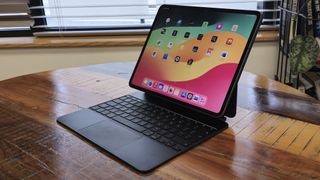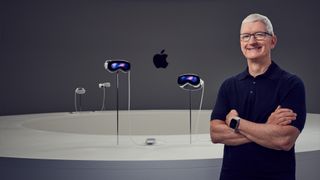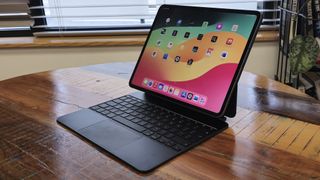When rumors started popping up that this year’s WWDC 2024 event (which kicks off shortly – head to our WWDC 2024 live blog for up-to-the-minute coverage) wouldn’t feature any new hardware from Apple, I was disappointed, and I’ve been readying myself for a rather lackluster keynote event, sitting through an hour or so of someone talking about how exciting a load of new artificial intelligence features are (basically the same presentation a seemingly endless line of tech brands has subjected to me over the past 12 months).
However, the more I’ve been thinking about what Apple might announce today – and what I would like it to announce – the more I’ve come to realize just how important WWDC 2024 is for Apple.
As a tech journalist – and consumer – who’s primarily interested in Apple’s Mac and MacBook devices, the past few years have been particularly exciting, with Apple ditching Intel and creating its own ARM-based M-series chips, and creating a new generation of Macs that blow the competition out of the water when it comes to performance, battery life, and even value for money. I’d never thought I’d ever say it, but if someone tells me they’re looking for a great cheap PC, I’d encourage them to get a Mac mini.
However, in 2024, things are changing rapidly. As we’ve seen at events such as Microsoft Build 2024 and Computex 2024, Windows 11-based laptops built on similar ARM-based chips are finally becoming real competitors to modern Macs and MacBooks.
As I’ve written previously, this renewed threat from Windows on ARM devices should provoke Apple to come out swinging with a new generation of Macs – but it looks like that won’t be happening, at least not at WWDC 2024.
Instead, it feels like Macs and MacBooks have slid down the list of Apple’s priorities. Not only will we likely not see any new models at WWDC 2024, but Apple’s decision to debut its latest M-series chip, the M4, in the iPad Pro (2024), rather than a Mac, was seen by some as at best, a realigning of Apple’s priorities – and at worst a snub to Macs.
As for what I think? Having used the iPad Pro 13-inch (2024) for almost a month now in place of my MacBook, I worry that Apple isn’t quite sure what it wants modern MacBooks or iPad Pros to be.

i-dentity crisis
The iPad Pro 13-inch (2024) is a gorgeous bit of tech, and with the new M4 chip beating away at its heart, and connected to the new Magic Keyboard accessory, you essentially get a thin and light MacBook with a stunning OLED touchscreen.
This introduces something of an identity crisis, however – for both the iPad Pro and the MacBook. If you own a recent MacBook, or are looking to buy one, you might be wondering if picking up an iPad Pro is a better choice – after all it comes with the most recent Apple hardware, and a screen that beats almost any display you’ll find in a MacBook.
The problem is that, for all its great points (it got a rare 5-star review from me), the iPad Pro (2024) is held back from being a viable MacBook replacement by Apple itself.
The problem is iPadOS, the mobile operating system that powers the iPad Pro (and other iPads). Because it’s an operating system built for mobile devices – and needs to run on the entire range of iPads, including less powerful editions such as the iPad mini – you’re stuck using iPad apps, rather than full-featured desktop Mac apps.
So, multitasking becomes much more frustrating on an iPad compared to a Mac, and you’re forced to use the mobile version of Chrome (for example), which lacks features such as extensions, which are essential for a lot of day-to-day work. It’s the same with apps like Word, Photoshop and others – you’re stuck using the mobile iPad app versions that usually lack all of the features of the full application that’s available for Macs and Windows 11 PCs.
It’s why I’ve returned to using my MacBook and Windows 11 PC for working on. However, while the iPad Pro (2024) can’t quite achieve the same level of productivity performance that Macs have, it also has problems if you just use it as a standard tablet.
Why? Because the hardware, especially the M4 chip, is massively overpowered for pretty much any standard task you’d want to do on an iPad. Considering the extremely high price tag of the iPad Pro, apart from some extreme edge cases, most people would be better off buying a much more affordable iPad instead.
The problem is, for those who are in need of the kind of power the M4-toting iPad Pro offers, you may actually be better off getting a MacBook or Mac.
Which then leaves the question: who is the iPad Pro (2024) for? It doesn’t feel like Apple really knows – so one of the things it needs to do at WWDC 2024 is show us.
One way to do this – which I am almost 100% sure Apple will never do – is allow macOS apps to run in iPadOS – or even allow macOS to be installed on the iPad Pro. This would massively boost the potential of the iPad Pro to be a real Mac alternative.
Sadly, this is unlikely to happen, and well-known Apple leaker Mark Gurman has made that clear in his latest newsletter to subscribers. As Gurman explains – and I agree heartily with him – Apple is unwilling to bring macOS to the iPad Pro for a rather simple reason: money.
The iPad ecosystem is heavily locked down, which means you can only install apps on an iPad via Apple’s App Store – and Apple takes a healthy chunk of profit from every app downloaded from the App Store.
Meanwhile, macOS is relatively open for a piece of Apple software. While there is an App Store for macOS which offers an easy way to find and download applications, you can also download applications from other sources such as from the application’s website, and games can be installed from stores such as Steam. Making iPadOS even remotely like macOS when it comes to apps is going to be out of the question. In fact, it would be far more likely that Apple makes macOS more like iPadOS, rather than the other way around – and that, of course, would be a nightmare.

What about Macs?
As for Macs and MacBooks, it’s very likely that Apple will announce macOS 15, a new operating system for its computers, along with a number of new – and no doubt AI-powered – features. While I would love to see new M4-powered MacBooks at WWDC, I’ve made peace with the fact that this is unlikely to happen.
So, what Apple needs to do, in my opinion, is show that it is still invested in Macs, and announce a version of macOS that’s packed with innovative features that can make our lives easier – and which fully take advantage of the power of the Mac.
Apple’s spin on AI is pretty much a given, so Apple will need to show how its AI implementation actually can help make a difference to our day-to-day lives – something I feel the likes of Microsoft and Google have failed to do with their AI additions.
How can AI fundamentally change how we use macOS? Rather than just making Siri better on all of its devices, let’s see some Mac-specific AI features. And at least give us a hint of M4 Macs coming soon – otherwise, Apple AI could feel like just another fad…

Oh, Apple Vision Pro, where art thou?
Speaking of fads, it’s time for Apple to prove that the Apple Vision Pro isn’t one. While the announcement of Apple’s high-tech (and very expensive) headset at last year’s WWDC, and its US launch earlier this year, garnered a lot of excitement, I get the feeling a lot of it has fizzled out.
Setting aside rumors that suggest sales haven’t been all that impressive, Apple has yet to show off any killer app that makes people want, or need, a Vision Pro headset. Instead, we’ve got some nice apps that aren’t particularly unique, and some iPad apps that can be viewed virtually. Where are the VR games? Where are the experiences that can only be had with a Vision Pro?
We’ve not had any major new game-changing apps for the Apple Vision Pro, and the lack of news about a possible worldwide release has left many of us (especially those like me living in a market, in my case the UK, where the Vision Pro hasn’t yet released) wondering if the Vision Pro is being forgotten about by Apple itself. The lack of news has also created a vacuum which is being rapidly filled with articles from Vision Pro owners complaining about how they never use the accessory anymore.
Take the recent iPad launches – unless I missed it, Apple didn’t talk about the Vision Pro at all. Sure, the launches were about iPads, so obviously the company would focus on them, but we could have been shown how the Vision Pro interacts with the new iPads – such as being used as a second screen, as it can be with Macs. Instead, we didn’t hear a peep about Apple’s expensive accessory, which launched only a few months ago.
Apple is going to have its work cut out to get the Vision Pro hype flowing again at WWDC 2024. We’ll need to see killer apps, a clearer vision of who the headset is for, and a demonstration of how, despite its sky-high asking price, it’s an essential product that could change our lives. If Apple doesn’t do that, then even with an announcement that it’s coming to more countries across the world the Vision Pro could be one of Apple’s most expensive mistakes.
So no pressure, then, Apple.
You might also like
Services Marketplace – Listings, Bookings & Reviews
